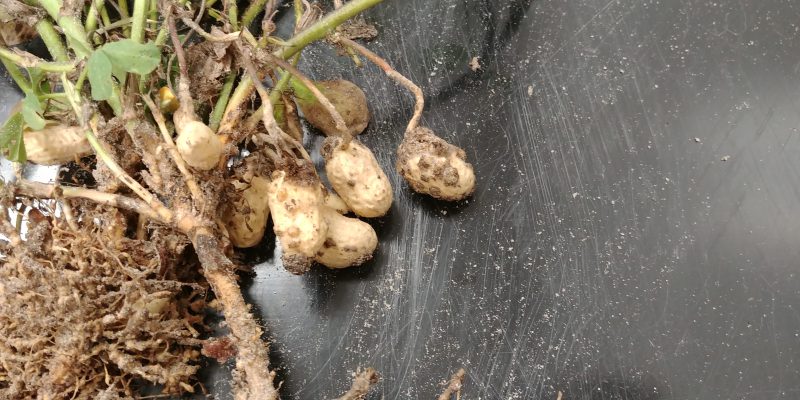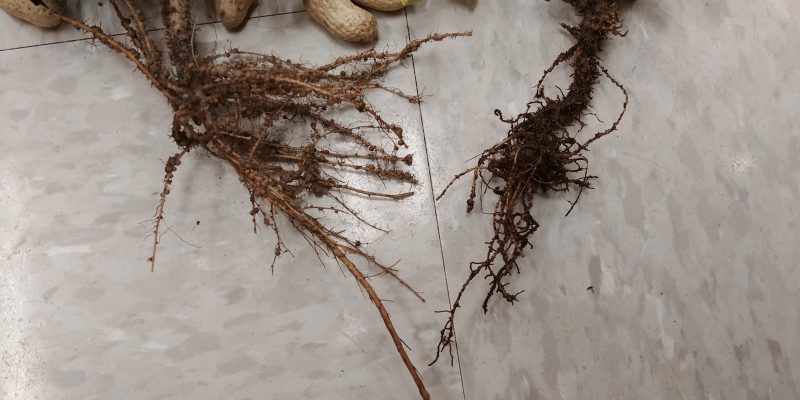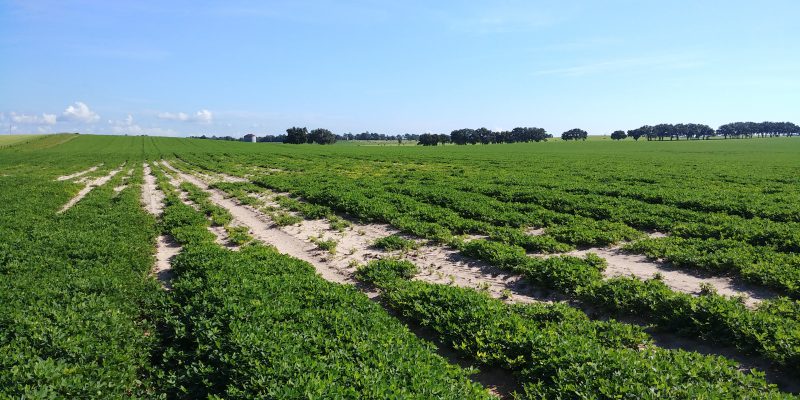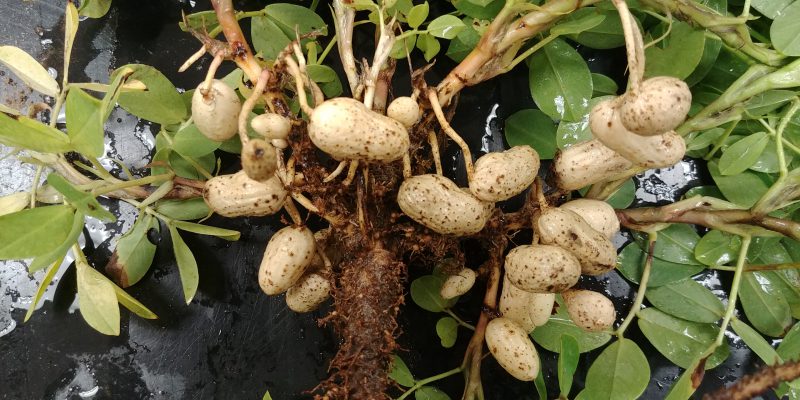Most agriculture professionals recognize that plant-parasitic nematodes can drag down peanut yield. In the Southeast, peanut nematodes are often assumed to be peanut root-knot nematodes (Meloidogyne arenaria and Meloidogyne javanica) because they are widespread, highly-damaging, and their symptoms are relatively distinct. However, Florida peanut growers deal with other nematodes as well—namely sting nematode (Belonolaimus longicaudatus).
Sting nematodes are highly-damaging to peanuts, with a single nematode detected in a soil sample enough to warrant management. Sting nematodes cause yellowing (chlorosis), stunting, or death of plants, resulting in patches with a skippy stand (Figures 1 and 2). These above-ground symptoms are often obvious early in the year, unlike root-knot nematode symptoms which generally appear later in the year from July-August. Symptoms of root infection also vary between these nematodes. Root-knot nematode causes distinct galls—irregular swelling—on peanut pods and roots (Figure 3). Sting nematode does not cause galls, but rather stunts the root system and prunes lateral roots (Figure 4) and causes tiny, pin-prick size brown lesions on the pods (Figure 5). This impairs root system function which leads to above ground symptoms and overall reduced growth.

Figure 2. Healthy (left) versus sting-infected peanut plant (right). Note the stunted shoot and yellowed foliage in the infected plant.

Figure 3. Galling (irregular-shaped swellings) on peanut pods and roots from root-knot nematode infection.
Recognizing these symptoms on peanut plants is informative as a first step in diagnosing a potential nematode problem. However, soil sampling and analysis by a professional nematology lab is needed to confirm which nematodes, if any, may be contributing to poor crop growth. In addition to the symptoms mentioned above, the fact that sting nematode prefers very sandy soil (typically 90% or more sand and little organic matter) can be useful in guiding sampling. Full information about sampling for nematodes, and other considerations for managing nematodes in peanut production, is provided in the EDIS publication – Management of Plant-Parasitic Nematodes in Florida Peanut Production. Growers are encouraged to contact their local Extension Ag Agent or myself for assistance with sampling. The UF/IFAS Nematode Assay Lab provides free service for Extension Agents submitting nematode samples to diagnose a problem in commercial production (limited number of samples per grower). Unfortunately, there is little that can be done for a current crop, if nematodes are detected, but nematode diagnosis can be used to guide future management decisions.

Figure 4. Healthy (left) versus sting-infected peanut roots. Note the stunted and decaying root system and pruned lateral roots in the infected plant.
At this point, you may be asking why it matters from a practical perspective what nematode is infesting a field? The answer is the success of a particular management strategy varies by the type of nematode infesting a field. The major management strategies for nematodes are nematicide application, crop rotation, and resistant cultivars. Resistant peanut cultivars (Tifguard, Georgia 14N, TifNV High O/L) are available for root-knot nematode, and substantially reduce damage from root-knot nematode. There is no evidence that these resistant peanut cultivars are effective against sting nematodes, so these cultivars are not an effective management strategy for sting nematodes. The host range of these nematodes vary, so an effective crop rotation varies depending which nematode is present. For both nematodes, it may be difficult to find an effective rotation because they have wide host ranges, but, for either nematode, some type of rotation is better than continuous monoculture. For peanut root-knot nematodes, soybean is among the most susceptible rotation crops, and should be avoided while cotton is a good rotation crop. Grasses are highly susceptible to sting nematode, so avoiding grass crops will help manage sting nematode. The efficacy of nematicides is relatively similar for both sting and root-knot nematodes, although sting nematodes are sometimes more affected, and thus more easily managed by nematicides.
–
In summary, agricultural professionals should:
–
1. Be on the lookout for symptoms of nematode infection.
–
2. Sample for nematodes and submit to a professional nematology lab, if infection is suspected.
–
3. Chose future nematode management strategies based on the type of nematodes present in a given field.
- Salibro: A Recently-Registered Conventional Nematicide for Select Horticulture Crops - March 7, 2025
- What Cotton Cultivars have Resistance or Tolerance to Southern Root-knot and Reniform Nematode? - February 28, 2025
- How Well Do Root-Knot Nematode Resistant Peanut Cultivars Perform in Florida? - February 14, 2025


